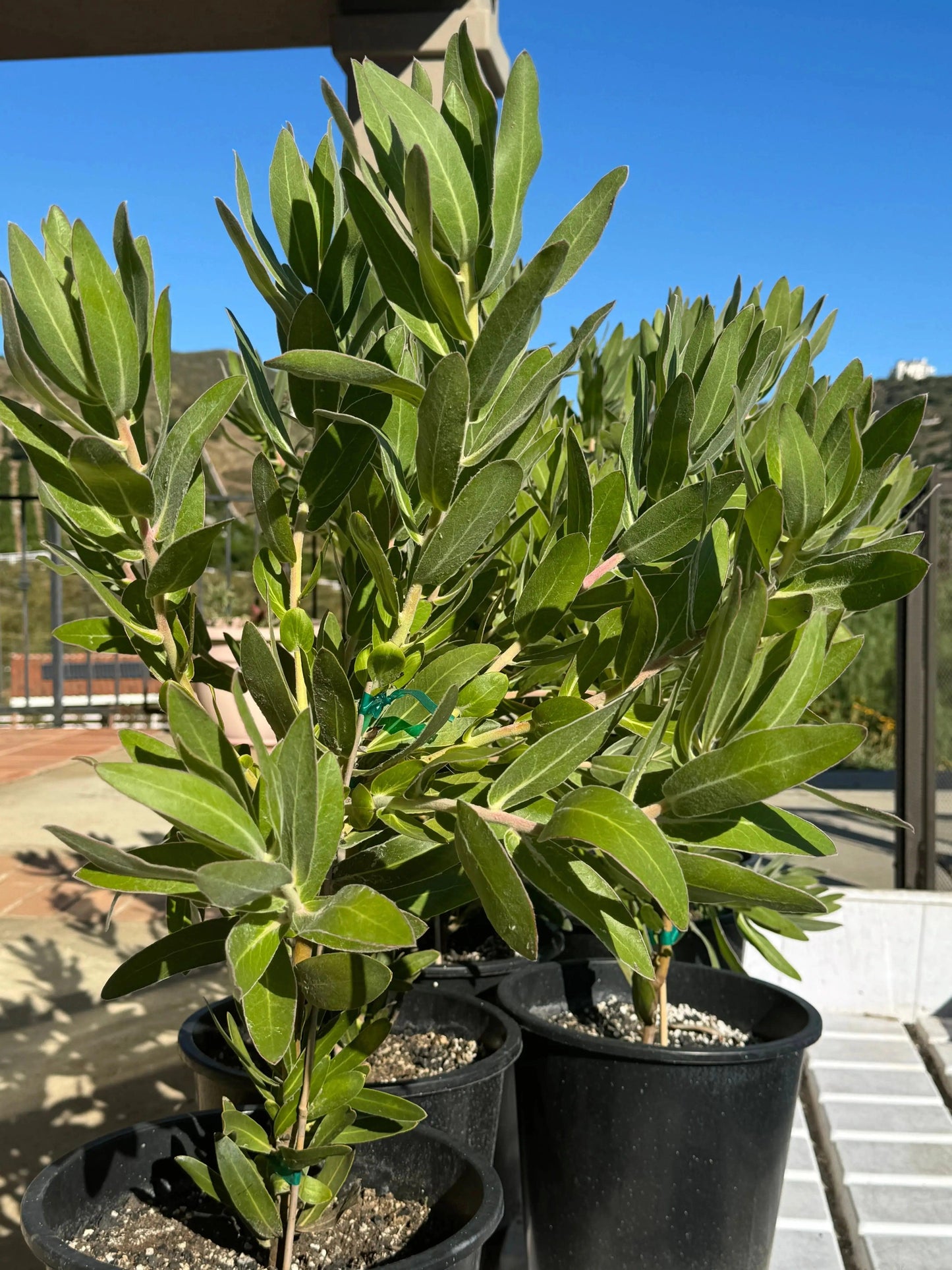Bonte Farm
Protea 'Trish Compacta': Dwarf, Heavy-Blooming Pink Protea for Containers
Protea 'Trish Compacta': Dwarf, Heavy-Blooming Pink Protea for Containers
Couldn't load pickup availability
✨ Protea 'Trish Compacta': The Tiny, Prolific Pink Gem
The Protea 'Trish Compacta' is a highly sought-after dwarf Protea hybrid celebrated for its exceptionally compact size and its ability to produce a surprisingly high volume of flowers. This remarkable evergreen shrub is the ideal choice for small gardens or container planting. It produces abundant, small to medium-sized blooms in a beautiful blend of soft pink and cream, often featuring black-tipped floral parts, contrasting elegantly with its neat, bluish-green foliage. 'Trish Compacta' is a superior, low-maintenance specimen perfect for adding architectural interest and color to patio containers, rockeries, and small Mediterranean gardens. Its manageable size, excellent drought tolerance, and prolific flowering make it a reliable favorite, yielding superb long-lasting cut flowers.
Botanical Characteristics
|
Characteristic |
Detail |
|
Scientific Name |
Protea 'Trish Compacta' (Hybrid Cultivar) |
|
Common Names |
Dwarf Trish Protea, Compact Pink Protea. |
|
Growth Habit |
A dense, dwarf evergreen shrub with a naturally compact and mounding habit, perfect for small spaces. |
|
Foliage |
Features slender, bluish-green leaves that are slightly curved and densely cover the stems, adding texture. |
|
Flowers |
Small to medium-sized, cup-shaped flower heads (bracts), typically 3–4 inches in diameter. Color is a blend of soft pink and creamy white, often with black tips. |
|
Flowering Season |
Known for its prolific, extended bloom period, typically flowering heavily from late fall through spring, providing essential cool-season interest. |
|
Cut Flower Use |
Excellent long-lasting cut flower, manageable size is ideal for small floral work and bouquets. |
Mature Size
'Trish Compacta' is one of the smallest and best-suited Proteas for containers.
- Height: Typically reaches a diminutive 2–3 feet (0.6–0.9 meters) tall.
- Spread: Achieves a dense, mounding spread of 2–3 feet (0.6–0.9 meters) wide.
- Its dwarf size is its key feature for modern, small-scale designs.
USDA Hardiness Zone
This Protea hybrid is best suited for USDA Hardiness Zones 9–11. It thrives in mild, nearly frost-free coastal and Mediterranean climates where it receives full sun. In colder zones, it is highly recommended for container gardening so it can be moved indoors during deep frost.
Cultivation and Care
|
Aspect |
Care Instructions |
|
Sunlight |
Requires full sun (a minimum of 6 hours of direct sun daily) and excellent air circulation to ensure dense, healthy growth. |
|
Soil |
Essential: Demands perfectly well-drained, acidic soil (pH 5.0–6.0). Use a sandy or gritty mix, especially in containers, and must not sit in heavy, wet clay. |
|
Water |
Highly drought-tolerant once established. Water deeply during the first year. Mature plants require minimal summer water; overwatering is highly detrimental. |
|
Fertilizer |
Crucial: ABSOLUTELY AVOID all phosphorus fertilizers. Proteas are extremely phosphorus-sensitive. Use a specialized, low-phosphorus formula for Proteaceae, or none at all. |
|
Pruning |
Mandatory: The best practice is to harvest the flowers heavily, cutting the stems back into the leafy part of the shrub. This helps maintain its compact, dense shape. |
Landscape Use
- Container Gardening: Perfect for pots and raised beds, allowing for easy control of soil and drainage.
- Rock Gardens: Used as a low-growing focal point among stones and gravel.
- Small Spaces: Ideal for front borders, pathways, and any small Mediterranean garden where space is limited.
- Xeriscape Design: A versatile, low-water, low-fertility plant for arid landscapes.
Wildlife Attraction
The flowers produce a sweet nectar, making them attractive to nectar-feeding birds, which serve as the primary pollinators. Planting 'Trish Compacta' is an excellent way to attract hummingbirds to patio areas.
Pest and Disease Resistance
Protea 'Trish Compacta' is generally a hardy and robust plant when its crucial drainage needs are met. The most common issues are root rot and collar rot, which are caused by poor soil drainage or overwatering—this is the single most critical factor to avoid.
Propagation
To ensure the resulting plant maintains the specific, desirable traits, dwarf habit, and soft pink color of the 'Trish Compacta' cultivar, propagation must be conducted using vegetative methods. Semi-hardwood cuttings are the preferred and most reliable technique, generally taken during the warmer months. Propagation from seed is not used for maintaining cultivar identity.
Propagation
The species is commonly propagated from seed, which is reliable but may result in slight variation. For home garden use or to maintain specific color forms, propagation through semi-hardwood cuttings is preferred, generally taken during the warmer months.
Share











FAQs
Got a question? We are here to answer











